
Commersonia is a genus of twenty-five species of flowering plants in the family Malvaceae. Plants in this genus are shrubs or trees, occurring from Indochina to Australia and have stems, leaves and flowers covered with star-like hairs. The leaves are simple, often with irregularly-toothed edges, the flowers bisexual with five sepals, five petals and five stamens and the fruit a capsule with five valves. The genus underwent a revision in 2011 and some species were separated from Commersonia, others were added from Rulingia.

Podolepis is a genus of flowering plants in the tribe Gnaphalieae within the family Asteraceae. It is endemic to Australia and can be found in every state.

Ozothamnus is a genus of plants found in Australia, New Zealand and New Caledonia.

Comesperma is a genus of shrubs, herbs and lianas in the family Polygalaceae. The genus is endemic to Australia. It was defined by the French botanist Jacques Labillardière in his 1806 work Novae Hollandiae Plantarum Specimen. The genus name is derived from the Ancient Greek words come ("hair") and sperma ("seed"), and relates to the seeds bearing tufts of hair. The genus is distributed over southern Australia, particularly in the southwest of Western Australia, where 19 species are found. 24 species have been described.
Chthonocephalus is a genus of annual herbs in the family Asteraceae. The genus is endemic to Australia, with species occurring in all mainland states.
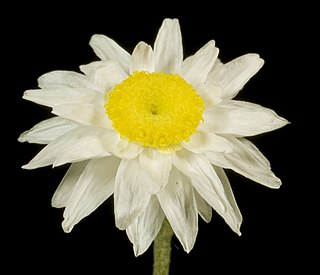
Hyalosperma is a genus of Australian flowering plants in the family Asteraceae.
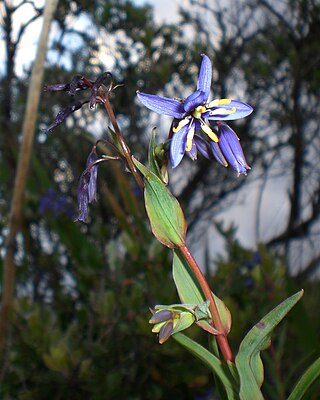
Stypandra glauca, commonly known as nodding blue lily, is a flowering plant in the family Asphodelaceae. It is a rhizomatous perennial plant with blue lily-like flower with yellow stamens. It is widespread across southern areas of Australia.

Asteridea is a genus of flowering plants in the family Asteraceae. Evidence suggests that the genus, Asteridea, is monophyletic.
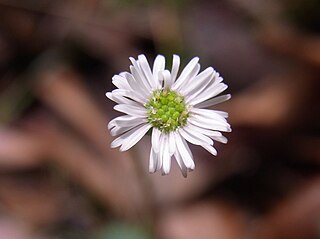
Lagenophora gracilis is a small plant in the family Asteraceae, found in eastern Australia, and in tropical Asia. Common names include slender bottle-daisy and slender lagenophora. The habitat is the floor of Eucalyptus forests, often in moist situations.
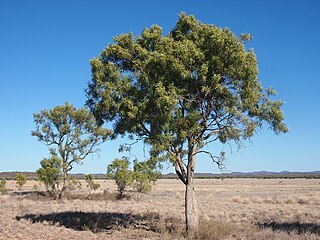
Atalaya hemiglauca, commonly known as whitewood or cattle bush, is a species of plant in the soapberry (Sapindaceae) family. It is native to northern and inland Australia where it occurs from Western Australia through the Northern Territory and South Australia to Queensland and northern New South Wales.

The National Herbarium of New South Wales was established in 1853. The Herbarium has a collection of more than 1.4 million plant specimens, making it the second largest collection of pressed, dried plant specimens in Australia, including scientific and historically significant collections and samples of Australian flora gathered by Joseph Banks and Daniel Solander during the voyage of HMS Endeavour in 1770.
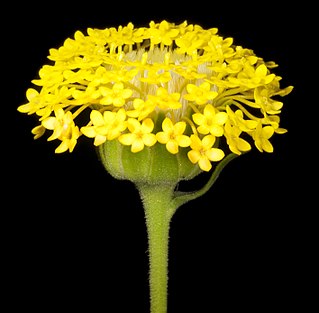
Podotheca chrysantha is a small herb in the family Asteraceae endemic to Western Australia. It grows from 0.2 to 0.5 m high, and has yellow flowers which are seen from August to December. It grows in sand over limestone or laterite on limestone ridges and in wet depressions.
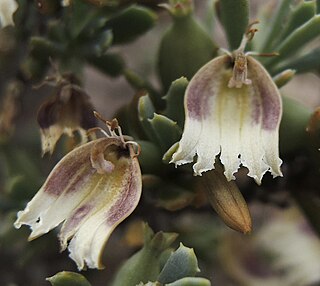
Scaevola collaris is a shrub in the family Goodeniaceae and its native range is five mainland states/territories of Australia: the Northern Territory, New South Wales, South Australia, Queensland and Western Australia.

Podolepis canescens is a herb in the Asteraceae family, which is found in South Australia, the Northern Territory, New South Wales and Victoria. PlantNet also states that it is found in Western Australia, but FloraBase states that the name is misapplied in Western Australia, based on Jeanes (2015).
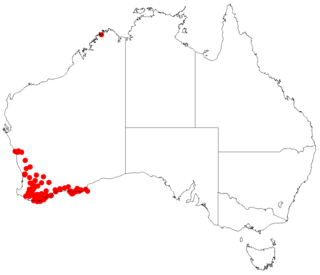
Asteridea nivea is a herb in the Asteraceae family, which is endemic to Western Australia. It was first described in 1845 by Joachim Steetz as Chrysodiscus niveus. In 1980, G. Kroner assigned it to the genus, Asteridea, giving it the name Asteridea nivea. It is a perennial herb, sometimes erect, sometimes low-spreading which grows on sandy soils often over granite, laterite, or limestone to heights from 10 cm to 60 cm, in rock crevices, on ridges and coastal cliffs. Its white to white-pink flowers may seen from April to May or August to September in Beard's South-West Province, that is, the IBRA regions of Avon Wheatbelt, Esperance Plains, Geraldton Sandplains, Jarrah Forest, Mallee, and Warren.

Codonocarpus cotinifolius a tall shrub or tree in the Gyrostemonaceae family is a found in all mainland states of Australia, including Victoria, and is widespread in arid areas. It is suspected of being toxic to stock.

Comesperma integerrimum is a twining shrub or climber in the family Polygalaceae.

Tribulus occidentalis, common name perennial caltrop, is a species of flowering plant in the family Zygophyllaceae, which is native to Australia, and found in Western Australia, Queensland, South Australia and the Northern Territory.

Pterochaeta is a monotypic plant genus in the Asteraceae family, endemic to Western Australia. It was first described in 1845 by Joachim Steetz and its only species is Pterochaeta paniculata.

Schoenia cassiniana is a species of plant in the tribe Gnaphalieae within the family Asteraceae, native to Western Australia, South Australia and the Northern Territory. It was first described in 1829 by Charles Gaudichaud-Beaupré as Helichrysum cassinianum, but was transferred to the genus Schoenia in 1845 by Joachim Steetz.



















